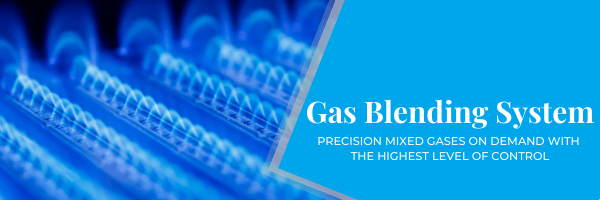
What is a Gas Blending System?
Gas blending system are used to combine various gases for specialised applications. These mixtures, or blends, are usually expressed by a molar fraction as a percentage or as a parts-per unit. The composition is usually expressed in parts per million (ppm) in gas blends where the quantity-per-quantity units are preferred.
Gas mixes with certain compositional ratios have a wide range of applications, ranging from industrial packaging to scientific research. Most gas blending systems are then utilized by manufacturers who produce premixtures for specific niches within this broad market cross-section, such as breathing gas mixtures for diving, modified atmosphere packaging (MAP) gases for the food industry, and so on.
So, what goes into a gas blending system?
Important Factors to Consider When Choosing a Gas Blending System
Let us have a look at some of the main elements to consider when designing the optimal gas blending system for your application. To begin, you will need to know the needed mixture ratios by molar fraction, as well as the various gases you will be mixing using the system. Using a conventional laser gas mixture as an example, this could be expressed as 71.35% helium (He), plus 19.25% nitrogen (N2), plus 9.40% carbon dioxide (CO2). Many gas blending solutions are highly precise, allowing you to precisely determine the concentrations of various constituent gases per combination.
This includes any mixes you intend to dilute. For continuous flow modes, you will additionally need to know the intended flow rate output, as well as the flow rate range for operations where use changes over time. The most sophisticated gas blending systems use calibrated mass flow controllers (MFCs) to keep flow rates for individual channels within the system. These work best within a scale range of 10 – 90% to achieve maximum reliability, and additional software controllers are required to adjust composition and flow rate of the mixed gas.
Finally, it is critical to know both the feed gas source pressure and the mixture delivery pressure to guarantee that all mixing set points are maintained throughout the process. This is because virtually all gas blending methods are pressure- dependent. In ideal conditions, you could perfectly mix gases together precisely by counting molecules – but this is impossible with today’s technology. This is closely approximated by molar flow measurement, commonly referred to as ‘mass flow measurement.’
Lab Unlimited and Fusion Flow Technologies
Lab Unlimited understands that every application is different that’s why we work with Fusion Flow Technologies to deliver gas bled designed to your specific needs. Using premixed gas cylinders is inconvenient and expensive, but the cost of ownership for existing gas mixing systems is typically prohibitive. Lab Unlimited creates effective tools by using Fusion Flow Technologies for precision mixed gases on demand with the highest level of control, reproducibility, and dependability.
Want to learn how you can get special mixed gas blend for your needs? Contact our Sales Team today.
Contact us Today! |
